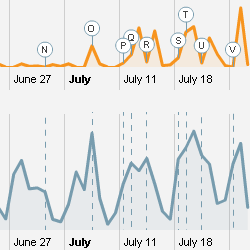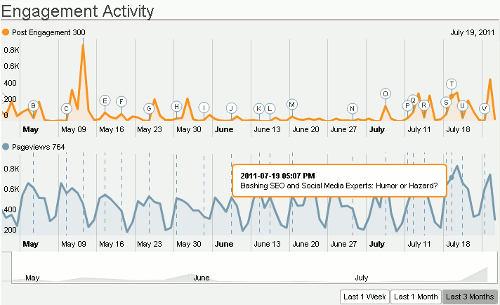
Good sense tells us to not give it all away upfront. If you kiss on the first date, anticipation often fades, and there may never be a second date. It may get you into their fantasies, or even into their bed, but this will seldom get you into their hearts, where trust and loyalty thrive. I find it easy to apply this to concepts of marketing.
I really believe in giving away a lot of great ideas for free. Sharing useful thought is one of the best reasons to blog. In fact, there should be little wonder why some of the most popular blogs are popular. It is because they are giving away great information that people want.
A free sample is great, but can it go too far? I believe it can, and I think it is likely why there are so many people like my example of “Pete and The Amazing Pee-Pants Pizza Parlor” in my recent article titled “Marketing Clients vs. Crybaby Sissy Bed-Wetters“ who think marketing should be cheap … or free … and easy.
The concern of giving away too much information for free is not limited to my field of marketing. There are a good number of idea-based and information-focused industries where there is a legitimate need to balance enough information to show credibility without inspiring people to do it themselves or shop for a “cheaper” option. Of course, there is always somebody to do it cheaper, but shoppers often forget there is a difference between good and bad in any industry.
People Understand Value of Items … But Ignore the Value of Information
Information is one of the most valued assets to a company. So how can it be so easy for people to neglect this fact from a buyer’s perspective?
I think of it along the lines of a recent freebie I received from Subway. Subway sent me a $10 gift card to try out their new pulled pork sub. When I used that freebie, I bought more than $10 from them. I’ll go back, too. It was a freebie associated with a promotion through Klout, a company I wrote about recently, and it gave me incentive to walk through Subway’s door, become a more active customer, and potentially bring others.
Since they are giving away tangible goods with a defined cost, people understand they cannot just give away the whole restaurant. When the freebie is something that comes right out of somebody’s thoughts or research, there is a common perception that it does not still have a cost. I guess you could think that way, but when my three kids get hungry because Daddy gave away the whole restaurant, I am inclined to disagree. There is a cost, and there is a point when you have to stop giving everything away. I know that point, and I intend to illustrate it.
Try Asking Somebody Close Enough to Know
When I recently asked my wife for her opinion of a project I am strongly interested in, she said something I guess I should have expected. Her chilling words were “You know the routine, Mark. You give people enough information that they think they know all they need to go shopping for somebody to do it cheaper.”
Of course, I stammer to inject the notion “but they cannot implement it like I can, and they can’t make a meal from a free sample of caviar.” Yes, and I can make that argument until I am blue in the face and holding my breath for the next soul-sucking chance to send another great marketing client to the wolves for a price comparison. It does not change the facts.
You see, I am literally the guy rocket scientists ask when they need a better strategy. They are in an industry that sells flights for over 200 million dollars per seat, and mistakes in their industry are expensive. These are bright people, but social media strategy is not their area of expertise. If I give them a big hunk of brain candy to munch on, it is easy for them to imagine that mister “SuperheroUnderpants” marketing guru in his mom’s basement can do the same job by promoting them on his MySpaceyTwitterBook.
The reality is that far too many of the people I share my brain-samples with use what I give them and go shopping for price. Sure, I can resent that, but it is my own fault. I kiss on the first date, like a sophomore girl hoping to be loved. Actually, I think I do worse than that … I get naked for the whole football team to come and enjoy. I do it all the time, but I am a lot better about it than I used to be. These days, I at least get them to buy me dinner and a movie before I strip myself naked.
I love marketing, but I hate selling the services of marketing. I am over-the-top, and almost autistically good at marketing “something else”. I can prove it, and I have earned millions of dollars because of it, but asking me to sell it is like asking to borrow a couple of my teeth.
Yes, marketing is awesome fun, but it feels like a daily trip to the dentist for a colonoscopy to promote and sell it. This is why I have often explained that When I Go to Hell, They Will Have Me Selling SEO.
I can man-up enough to admit that it actually made my chest hurt as I internalized my wife’s insight, but not because it was insulting or untrue. It was very true, and she went on to remind me about other stunning examples when giving too much killed my hopes. It has not just happened once or twice, either. Somebody attempts to brain-rob me every day, but I stick up for myself these days. It is because I have learned the hard way, and forgone great projects and sent them to SuperheroUnderpants who will work for a case of Red Bull and a pirated copy of the next Nintendo game.
A True Story of Giving Too Much for Free
One such project was with a company where I really felt I belonged. I already felt an emotional attachment to the brand and the people. In fact, I was prepared to uproot my family and move to a different city for them. We were already shopping for schools and homes. I wrote about it in the article titled “99 Percent of Marketing Fails, But Eleanor Can Fly!“ and a follow-up titled “How Good SEO Becomes Great SEO: Feed the Gorillas!” It was the perfect scenario … or so it seemed.
Where the ugly part came in was after I returned from our meeting in Chicago where they had wanted me to bring my vision and build a new marketing crew for them. As I look back, I suspect that even before my plane landed, they were seeking somebody who would try and implement my ideas for a fraction of the salary. They found one, too … but wait for the real kicker!
That “somebody” totally destroyed the campaign, and in fact, destroyed it so badly that it is hard to even describe. Let me give you the quick version. They sent a $70,000 motorcycle and a $5,000 guitar on tour with a Grammy award winning band to promote a giveaway. It was to have a significant social media marketing push behind it, and the company said they were very dedicated to my ideas. They already had a significant investment leading up to it. How significant? They bought the company that made the motorcycle, because they thought it fit well with their brand … the brand that I was to build.
Now get this: By the time they gave away that $75,000 in prizes, their Twitter account had under 350 followers, their Facebook account had about the same, and their YouTube account did not have a single upload. Not one video of the band, the motorcycle, the fans, the guitar … nothing!
They failed, and I know, with mathematics and two decades of very successful experience on my side, that they caused their own demise. Although you could call me guilty for not explaining that great plans fail without implementation and the right crew, I don’t feel guilty. I just feel bad for giving too much for free.
Defining Free vs. Paid Knowledge
Each of us will have ways to define giving away “too much”, but here are a few of mine. I hope they will inspire you to think about yours.
First and foremost … a client only needs to know enough about me to realize that I have sufficient marketing creativity, experience, and talent to make them more successful. Period! If they are unwilling to consume enough of my freebies to realize these things, they will not be the kind of client I can work with, because they will second-guess my advice. That is a true recipe for failure, the likes of which I refuse to be a part of.
Another key is anybody indicating they are still shopping around for price. When that is the case, there are no freebies beyond my blog. If they are looking for price above value, they are not the paying type. Even if they pay, they will stand in their own way. They simply are not ready. They are the ones who search Google for “How much does SEO cost?” (where I am listed on the top), and then email me because they were too rushed to get numbers to actually read the correct answer. If they don’t hire me today, they will come back in a year or two, jaded by the failure I tried to warn them about. Both scenarios are like a bad case of herpes … I don’t put my love there!
If they say they are interested in meeting in person, that is not going to happen without their dollars. I don’t pack bags for free. If somebody needs to shake my hand, they need to pay me for it. They are a buyer, and I am not about to turn them into a looker. There is always a reason to ask me to meet with them, and it always involves custom brain-work. The custom stuff is never free.
I have a long list of things which define what is free versus paid, but I want to know what you think.
Should We Give Away Less Brainflow?
It really isn’t so different from the restaurant or sporting goods store giving away a freebie. It cannot all be free, or the company is not sustainable.
I will never stop giving away free ideas, but those are the ones like the $10 Subway gift card to bring buyers through the door. I give enough that people understand my knowledge, creativity, and credibility. I also do it for the people who need help, but cannot afford to hire my services, and I feel good about that, too. I believe in altruism, but I also recognize that even Mother Teresa, Ghandi, and others do things for well-intentioned but calculated reasons, and that altruism in its purest sense, is not what people told you.
I have learned the hard way. If you are giving away something better than the stuff other people are selling for money, you will damn yourself to lackluster clients if you cannot bring them to understand that there is a lot more where the freebies came from … and it’s for sale!
I know that I’m not alone in this battle. I’ve heard it from many respected others in my line of work. If you can relate to this, I want to hear your stories. I would also love to hear from you about where you draw the line between free ideas and the ideas you count on to buy your lunch.
If you are giving away too much, I’d also be curious to hear how your back feels after sleeping on the couch because you bought into the myth that information is “free”. I’m sleeping in the big bed tonight. Later sucker!
Photo Credit:
Birthday Present by Christopher Matson via Flickr
Podcast: Play in new window | Download










